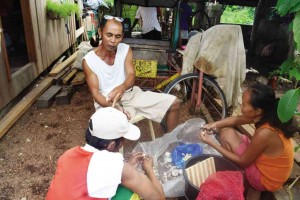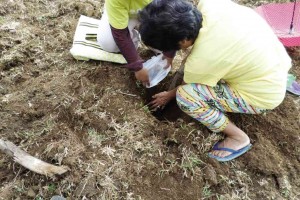‘Build back better’ is new battle cry

Farmers in the coastal town of Marabut, Samar, learn how to make a form of organic fertilizer called Oriental Herbal Nutrient.
In the land of supertyphoons, resiliency is what really matters.
The restaurant, one of many in the city center of Tacloban, used to be called “No problem.” That it is no longer so named seems to say it all for those who suffered the onslaught of Supertyphoon “Yolanda” a year ago.
The storm surge washed away the old name. Today it is called Cosina Juan Luna. According to a local resident, the menu has leveled up. And apparently the patrons, too, judging by the number of foreigners coming and going.
Eastern Visayas, not just the restaurant, is “building back better,” as the buzzword goes.
Yet, even as efforts switch gears from relief to recovery, and Tacloban appears to be rising back up, the picture away from the city is not as rosy—more so in areas far from the main road.
Here in the unseen parts, where most people are into farming and fishing, the sense of urgency is as palpable though largely unspoken.
There was a time when relief goods abounded. For early responders like the Netherlands-based InterChurch Organization for Development Cooperation (ICCO), it was a time of addressing the victims’ immediate need for food, shelter, health, water and sanitation, as well as the first steps to regain livelihood, education services, and legal help.
‘Demand-driven’
A year after Yolanda, the question on top of people’s minds was how to get back up on their feet, be self-reliant and, hopefully, prepared for the next disaster.
As the months progressed and the initial shock of Yolanda’s devastation passed, ICCO realized that activities needed to shift from the distribution of farm inputs like seeds, fertilizer and tools, as well as fishing gear, to skills training for better farm management and improved presence in the market.
The Protestant group provided humanitarian assistance in four cities and eight towns in seven provinces that were the hardest hit by Yolanda. Having been active in the Philippines for the past 40 years, ICCO understands that any effort to be undertaken must be “demand-driven”—with local communities themselves identifying and assessing the kind of projects or intervention most needed given the available resources.
ICCO is now working with at least 15 local organizations to better understand the needs and peculiarities of every community. Its partners include Action for Economic Reforms and Rice Watch Action Network (R1).
ICCO, through its network, helped rehabilitate at least 200 hectares of farms and provided inputs to close to 5,000 families. Now, through partners such as R1, the beneficiaries are learning how farming could be improved, making them less vulnerable to extreme weather events.
Hope
In Barangay Osmeña of Marabut, Samar, R1 is helping farmers determine which crops are suitable to the land they cultivate. With an average landholding of less than a hectare per farming household, this information may spell the difference between a good harvest or none at all.
For Roquelito Abellanosa, the fifth-class municipality’s only functioning agricultural technician, this fresh approach to farming has given him much hope.
“Many farmers here simply carry on with the ways of old, planting the usual crop at the usual time of the year, because that’s what they got used to,” sasy Abellanosa.
For example, he says, May or June may no longer be the right time to start planting because the rains do not come until July.
“That may seem like a very simple problem. But I have seen families forced to live on cassava or camote (sweet potato)—having it for breakfast, lunch and dinner—just because they soldier on with the old ways that are now failing,” Abellanosa says. “It’s heart-breaking.”
With training facilitated by R1, farmers learn the importance of intercropping.
Through the R1-organized Climate Resiliency Field School, the farmers also learn to time their crop cycles by weather observations. Further, the tillers are trained to make their own fertilizer from readily available natural ingredients such as garlic, bananas, fruit peelings and even sugar.
Barren soil
For these farmers, organic fertilizer helps rejuvenate the soil, while the more expensive commercial inputs actually rob the earth of nutrients. They believe that fillers—made of sand and gypsum—contained in chemical fertilizers eventually make the soil barren and more dependent on chemicals.
“Training by field school is better because we do the things ourselves,” says Teresita Salas, who tends a vegetable farm near a rice field. “If it were the usual classroom-type lecture with slide projections, I would not have learned as much. I’m weak in those things.”
In Carigara, Leyte, another ICCO partner decided to temporarily shift from financing activities to agricultural rehabilitation efforts. In Barangay Libo, the Kabuhayan Micro-Credit Inc. (KMI) started providing its community of borrowers with more practical assistance.
Buenaventura B. Dargantes, KMI president and professor of socio-ecology at the Visayas State University, says that when Yolanda struck, the group felt it was not the right time to continue its lending program.
“These people are mostly coconut farmers who had good track records as microfinancing clients. But after Yolanda, they needed something more appropriate,” Dargantes explains.
KMI started with helping clear the farms of debris, mainly coconut trees. If left untended, the rotting trees could become a breeding ground for pests.
Practical training
From there, KMI assistance turned to training farmers on alternative livelihood and crops, and soil analysis. The objective is to move further on to marketing the farmers’ crops, make them aware of their role in the value chain and move up.
Mabel Ruedas, is currently preparing a half hectare portion of her tenant family’s landholding for growing corn and camote. The lot used to be mostly idle. Lately, Ruedas learned that the land was fully suited to corn and camote.
“I can see the importance of practical training,” Ruedas says. “I would not have understood soil analysis with those concepts and gadgets that we used, if I did not myself dug up for soil samples and observed the farm.”
For many in the community of Libo, it was news that the presence of amor seco—a perennial herb which is more like weed—meant that the soil lacked nitrogen, a major component of

Coconut farmers in Carigara, Leyte, learn a thing or two from scientists on how to properly analyze soil.
commercial fertilizers.
But rather than go for chemical mixtures, the farmers tried an organic brand which, although expensive, could prove to be more beneficial because the soil would retain its nutrients.
KMI volunteer Dennis Ravas, whose day job is teaching European languages, observes that there are forms of aid that address immediate but passing needs, and there are others that stay with the beneficiary even after a long time has passed and conditions have changed.
He said that during the first few weeks after the supertyphoon, relief goods were so abundant that people got sick and tired of canned sardines.
“I held on because of a small clump of kangkong and camote shoots that miraculously survived in my yard—a piece of roofing fell over them and saved the plants from the harsh winds,” Ravas recalls. “Without those straggling plants, I would not have been able to eat the sardines that even the dogs shun.”
According to the teacher, Yolanda taught him that being alive, in simplest terms, means producing and growing your own food.
“Those green shoots meant hope for me, especially when all you can do at the moment is to just live on,” he says. “If those plants were thriving, it meant I myself would survive.”
Ravas could have been describing the farmers themselves.